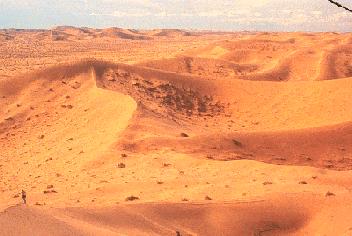DESERTS AND WIND ACTION

The photo shows a
group of active star dunes in the desert--blowing sand can etch windows and
shifting sand dunes can interfere with buildings and airports in desert regions
I. Desert regions
and wind erosion
A. Desert and adjacent regions
1. Deserts
·
are
those regions on Earth which are categorized as having arid climates
2. Steppes
·
are
those regions adjacent to deserts categorized as having semiarid
climates--steppes separate arid and humid climates
·
click here to see the Earth climate zones or see
page 289 in text
B.
Wind erosion processes
1. Deflation
·
is
the removal of rock waste from the land by the wind
·
a
blowout or deflation hollow is a depression excavated by the wind in easily
eroded materials such as sand or silt deposits with little or no moisture or
vegetation content--vegetation present in materials at the surface impedes
deflation
·
click here to see a blowout or see
page 297 in text
2. Abrasion
·
is
the grinding and scraping of a rock surface by the friction and impact of rock
particles carried by the wind--it results in a "sandblasting" effect
of the rock causing the rock to be polished and smooth-see
page 299 in text
C.
Wind erosion loads
1. Suspended load
·
suspended
materials in the wind consists primarily of silt or clay size particles and if
highly concentration can result in dust storms--the deposition of the suspended
load can form large deposits which lack layering called loess – see
bottom of page 296 in text for a dust storm – see page 303 for a picture
of loess
2. Bed load
·
refers
to rock particles which are transported by a bouncing effect and consist
primarily of sand size particles--the accumulation of this type of load forms
the desert sand dunes (active dunes)
II. Active sand dunes
A.
Nature of active (unstable) dunes
·
the
dune slopes upward in the direction of the wind and is called the windward
slope--the slope then breaks downward sharply to a much steeper slope called
the leeward slope or slip face
·
click here to see the dune profile or see
page 301 in text
2. Shifting dunes
·
active dunes can readily shift positions down wind and bury roads,
airport runways, homes, etc.
B. Categories of active dunes--pictures
shown on page 301
- based on the shape of the dune in the map or plan view
·
is
a crescent shaped dune with the convex portion facing the wind direction and
formed when the wind direction is constant and the sand supply is limited
·
click here to see photo of barchans or see
page 302 in text
2. Transverse
·
is
a dune elongated perpendicular to the direction of the wind and formed when the
wind is constant and there is a large supply of sand--see page
301B in text
·
is
a dune elongated in the general direction of the wind and formed from slightly
different wind directions with a limited supply of sand
·
click here to see photo of longdunes
·
is
a dune formed when the direction of the wind is variable
·
click here to see photo of star dune
·
click here to see and review the sand dune types
III. Evolution of a desert landscape
- are fan shaped sediment
deposits formed at the foot of mountains in the desert valley or basin--if
there is a coalescence of alluvial fans an apron of sediment called a bajada is formed – see pages 294 and 295 for an alluvial fan
B.
Playa lake and playa
- a (shallow) playa lake may form in the central basin of
a desert from abundant rainfall on rare occasions-- because of evaporation
and infiltration the water in these lakes are present for only a few days
or weeks--the dry flat lake bed that remains is called a playa – see pages 294 &295 for another example of a playa
click here to see a photo of a bajada and playa lake
C.
Inselberg
- is an isolated erosional remnant formed after long term
erosion of the mountain areas which are reduced to these bedrock knobs
elevated above the surrounding sediment-filled basin
click here to seethe stages of landscape evolution in mountainous desert
regions (A=early stage, B=middle stage, C=late stage) or see page 294 in text
click
here for more information on deserts
IV. Inactive or stable
- the parabolic dune or fore-dune is the only type of
stable dune--typically this type of dune is formed along the coastlines of
oceans or large lakes--strong winds cause blowouts in the sand deposits
along the coastline resulting in a crescent shaped dune whose concave side
faces the direction of the prevailing wind
- return to see this type of dune